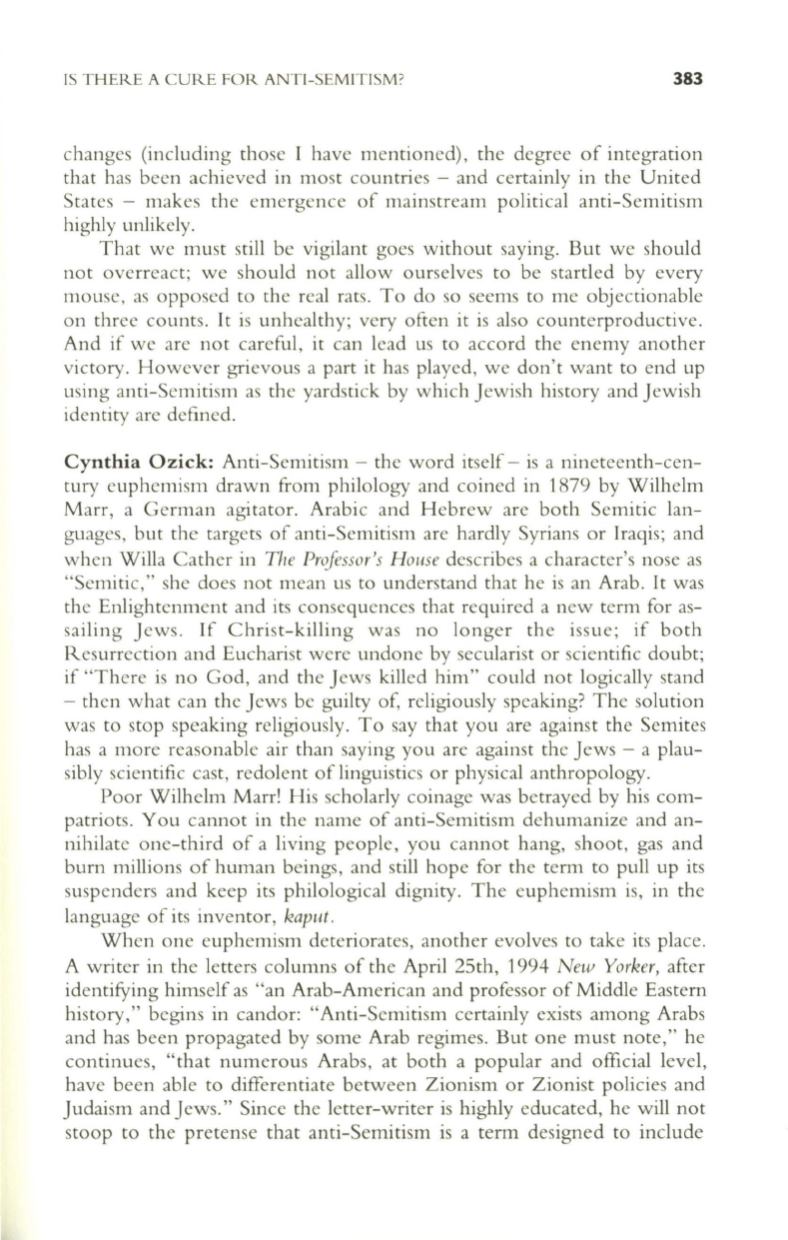
IS THERE A CURE FOR ANTI-SEMITISM'
383
changes (including those I have mentioned), the degree of integration
that has been achieved in most countries - and certainly in the United
States - makes the emergence of mainstream political anti-Semitism
highly unlikely.
That we must still be vigilant goes without saying. But we should
not overreact; we should not all ow ourselves to be startled by every
mouse, as opposed to the real rats. To do so seems to me objectionable
on three counts. It is unhealthy; very often it is also counterproductive.
And if we are not careful, it can lead us to accord the enemy another
victory. However grievous a part it has played, we don't want to end up
using anti-Semitism as the yardstick by which Jewish history and Jewish
identity are defined.
Cynthia Ozick:
Anti-Semitism - the word itself - is a nineteenth-cen–
tury euphemism drawn from philology and coined in 1879 by Wilhelm
Marr, a German agitator. Arabic and Hebrew are both Semitic lan–
guages, but the targets of anti-Semitism are hardly Syrians or Iraqis; and
when Willa Cather in
The Professor's HOl/se
describes a character's nose as
"Semitic," she does not mean us
to
understand that he is an Arab. It was
the Enlightenment and its consequences that required a new term for as–
sailing Jews. If Christ-killing was no longer the issue; if both
Resurrection and Eucharist were undone by secularist or scientific doubt;
if "There is no God, and the Jews killed him" could not logically stand
- then what can the Jews be guilty of, religiously speaking? The solution
was to stop speaking religiously. To say that you are against the Semites
has a more reasonable air than saying you are against the Jews - a plau–
sibly scientific cast, redolent of linguistics or physical anthropology.
Poor Wilhelm Marr! His scholarly coinage was betrayed by his com–
patriots. You cannot in the name of anti-Semitism dehumanize and an–
nihilate one-third of a living people, you cannot hang, shoot, gas and
burn millions of human beings, and still hope for the term to pull up its
suspenders and keep its philological dignity. The euphemism is, in the
language of its inventor,
kaput.
When one euphemism deteriorates, another evolves to take its place.
A writer in the letters columns of the April 25th, 1994
New Yorker,
after
identifYing himself as "an Arab-American and professor of Middle Eastern
history," begins in candor: "Anti-Semitism certainly exists among Arabs
and has been propagated by some Arab regimes. But one must note," he
continues, "that numerous Arabs, at both a popular and official level,
have been able to differentiate between Zionism or Zionist policies and
Judaism and Jews." Since the letter-writer is highly educated, he will not
stoop to the pretense that anti-Semitism is a term designed to include


